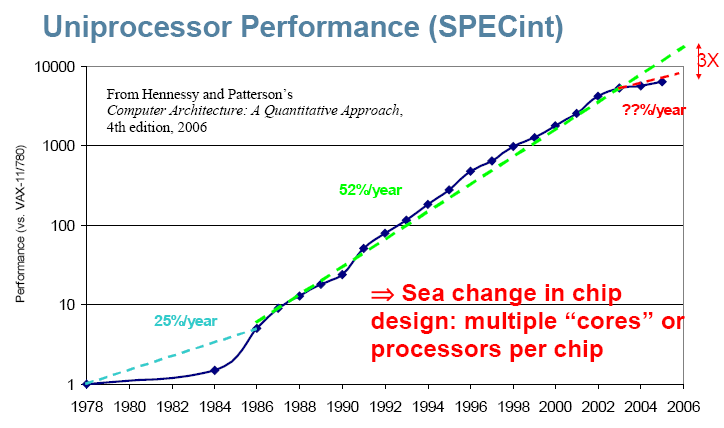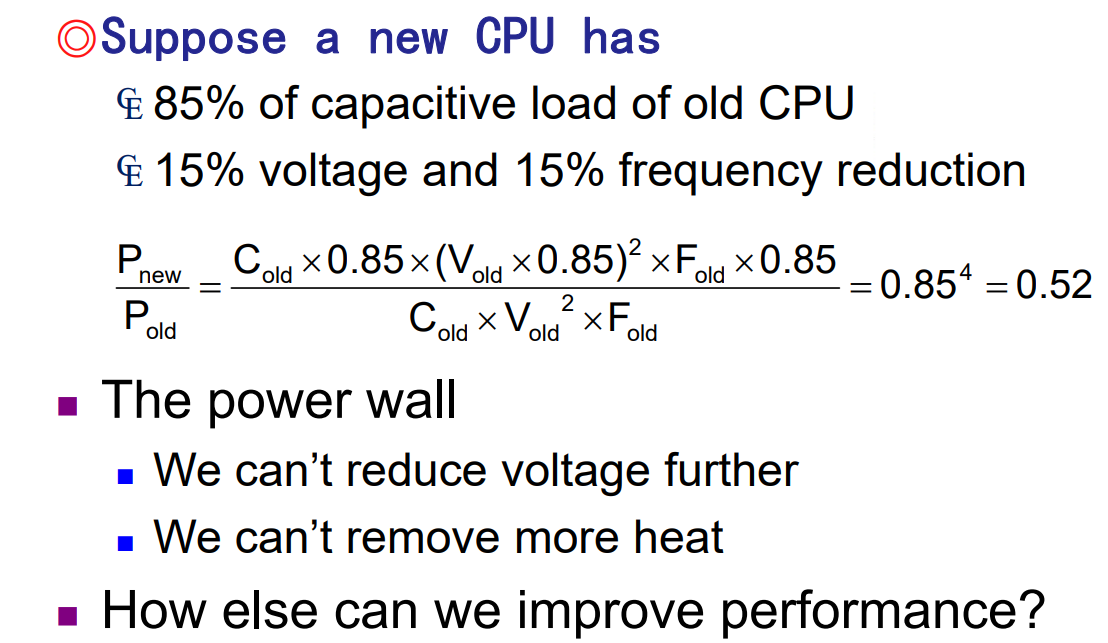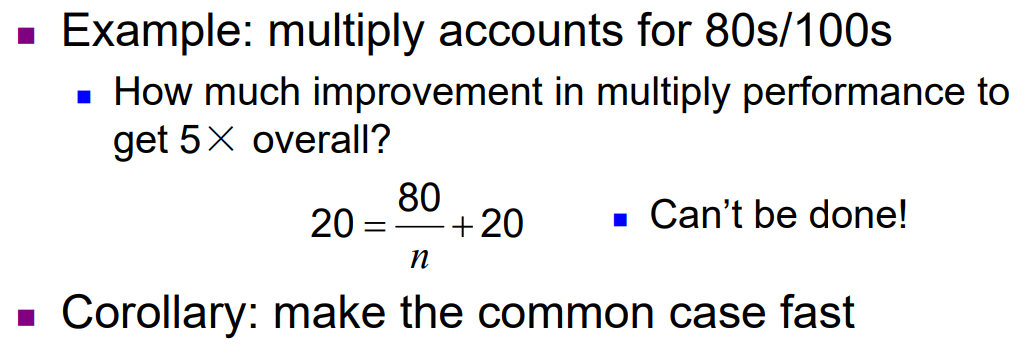Chapter 1 Computer Abstractions and Technology¶
Abstract
- 8 Ideas in Computer Architecture
- Performance
- Incredible performance improvement
8 Ideas in Computer Architecture¶
- Moore's Law
The integrate circuit resource double every 18-24 months. - User abstraction to simplify design(使用抽象简化设计)
- Lower-level details are hidden to higher levels
- Instruction set architecture -- the interface between HW and SW.
- Make the common cases fast(加速经常性事件)
- Performance via Parallelism(通过并行提高性能)
- Performance via Pipelining (通过流水线提高性能)
- Performance via Prediction(通过预测提高性能)
- Hierarchy of memory(存储层次)
- Dependability via redundancy(通过冗余提高可靠性)

Performance(性能)¶
- Response time(响应时间): How long it takes to do a task. (个体用户在意)
- Throughput (吞吐量): Total work done per unit time. (服务器重视)
Define \(Performance = \dfrac{1}{Execution\ Time}\)
Execution time(执行时间)¶
-
Elapsed Time (和响应时间一回事) Total response time, including all aspects e.g. Processing, I/O, OS overhead, idle time.
-
CPU Time (CPU 执行时间)
- 用户CPU时间(user CPU time)
- 系统CPU时间(system CPU time)
- 为了保持一致,我们保持区分基于时间的性能和基于CPU执行时间的性能,前者叫做系统性能(system performance),后者叫做CPU性能(CPU performance).
- Discounts I/O time, other jobs’ shares
- 这里我们只考虑CPU时间
CPU Clocking(CPU 时钟)¶
- Clock period: duration of a clock cycle.(周期长度)
用时钟周期代替具体的秒数。 - Clock frequency(rate): cycles per second. (周期频率)
CPI
- 指令平均时钟周期数(clock cycle per instruction)表示执行每条指令所需的时钟周期平均数,缩写为CPI。
- CPI is determined by CPU hardware.
- 如果不同指令有不同的 CPI, 我们可以用 Average CPI.
Performance improved by * Reducing number of clock cycles * Increasing clock rate * Hardware designer must often trade off clock rate against cycle count
综上, \(CPU\ Time = \dfrac{Instructions}{Program}\times \dfrac{Clock\ Cycles}{Instruction}\times \dfrac{Seconds}{Clock Cycle}\)
Performance depends on
- Algorithm: affects IC, possibly CPI
- Programming language: affects IC, CPI
- Compiler: affects IC, CPI
- Instruction set architecture :IC,CPI, 时钟频率
Incredible performance improvement¶
Uniprocessor¶
Three Walls
- Power Wall
\(Power = Capactive\ load \times Voltage^2 \times Frequency\)

Example

主频提高了很多,但功耗并没有得到这么多的提升,因为我们降低了工作电压 (5V-1V) 现在工作电压不能再降低了(否则泄漏电流占比太大),因此我们不能再提高功率了。
- Memory Wall
Memory 的性能增长不如 CPU 的性能增长,大部分时间花在读写内存了,影响整体性能。目前使用多级Cache - ITP Wall
difficulty to find enough parallelism in the instructions stream of a single process to keep higher performance processor cores busy. 指令集并行程度
Multiprocessors¶
requires explicitly parallel programming.
Amdahl's Law
Improve an aspect of a computer and expecting improvement in overall performance. \(T_{\textbf{improved}}=\dfrac{T_{\textbf{affected}}}{\textbf{improvement factor}}+T_{\textbf{unaffected}}\).
Example

Corollary: make the common case fast.
- Low Power Not at Idle.机器在没有工作时也有功耗损失。
-
MIPS as a Performance Metric
- MIPS: Millions of Instructions Per Second
- 这个参数需要在其他参数一致时,才有比较意义。不同的 ISA 之间不能仅凭 MIPS 比较。
SPEC Power Benchmark
- Power consumption of server at different workload levels
- Performance: ssj_ops/sec
- Power: Watts (Joules/sec)
- Overall ssj_ops per Watt = \(\frac{\sum\limits_{i=0}^{10}{ssj\_ops}_i}{\sum\limits_{i=0}^{10}{power}_i}\)